The celebrated Mr. K finds that sometimes the real hits are on the B side…

—
UPDATED 11/18/23: Diggin’ in the vault time — when we go deep into the recesses of the shadowy subterranean 13th Dimension headquarters for great columns that deserve another look. Just for kicks! This one first ran in May 2021. Right on! — Dan
—
Columnist Paul Kupperberg takes up a big challenge with this one — and I’m sure you have your faves too. (Mine is Batman #250’s “The Batman Nobody Knows!” by Frank Robbins and Dick Giordano. So dig Paul’s list, then feel free to add your own favorites in the comments. Oh! And check out Paul’s latest project too: Son of the Unpublished Comic Book Scripts of Paul Kupperberg. (Click here to order!) — Dan
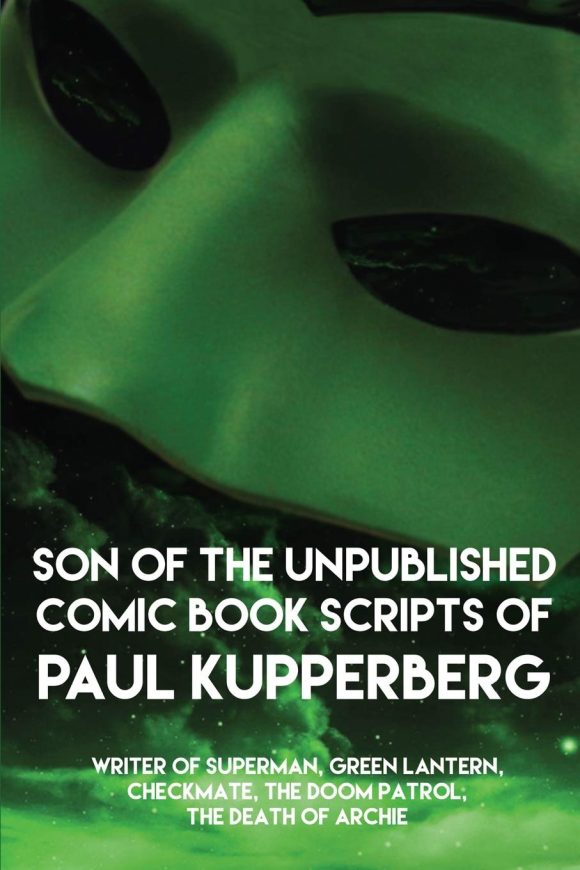
—
By PAUL KUPPERBERG
Back-up stories in mainstream comics used to be a lot more common than they are today. There were entire titles that were nothing but back-up stories, mostly genre books like House of Mystery, Strange Adventures, and just about everything Charlton Comics published. Back-ups were called that because they backed up the title slot in short stories that generally ran five to eight, sometimes 10 pages.
I always loved a good done-in-one back-up story. As a reader, they are the icing on the comic book cake, a sweet little bit of something extra topping an already delicious treat. As a writer, they’re an opportunity to do fun or interesting little one-off stories that focus on a single character or situation, capturing a moment or an event without any strings attached. They can also be a challenge to write; a six-pager runs about three dozen or so panels (assuming six panels per page), which doesn’t allow for wasted space or poorly paced storytelling.

On the other hand, when creators get it right, that’s when the magic happens. These are a few of the stories that stuck in my memory from my decades of comic book reading. There are dozens, likely hundreds, more if I did a really deep dive into different anthology comics, but for this week’s selections I’m sticking with superhero and action/adventure stories featuring ongoing characters. The only exception to the back-up feature rule I’ve allowed is the Will Eisner Spirit story because even though it headlined the publication in which it appeared, it’s a short comic book story and when you talk about short comic book stories, Will Eisner just has to be in the conversation.
Here then, MY 13 FAVORITE COMIC BOOK BACK-UP STORIES, in no particular order:
—
Detective Comics #324, DC (Feb. 1964). I jumped at Detective Comics #324 on the newsstand for the cover depicting Batman and Robin trapped and being gassed inside a giant robot head, but I returned next month for Detective Comics #325 after discovering the Martian Manhunter in the back-up spot, “The Beast Who Was J’onn J’onzz” by Jack Miller and Joe Certa.
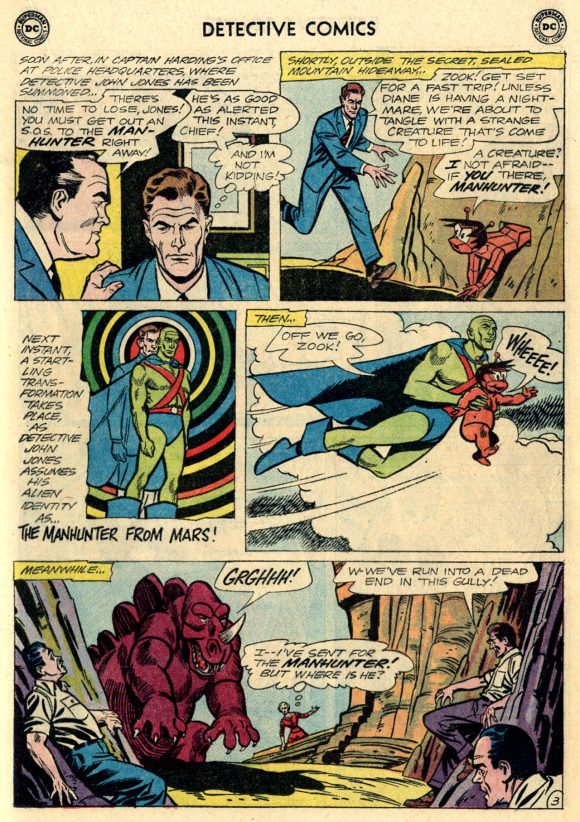
The story itself wasn’t anything to write home about—Martian Manhunter transforms into a variety of alien beasts and gets trapped in the form of a fire-beast because fire is like Kryptonite to Martians — but J’onn J’onzz himself was just awesome! He not only had all the same powers and abilities as Superman, but he was also a shapeshifter, he could turn invisible and intangible, and read minds! Why was this Super-Superman consigned to a back-up slot when the Man of Steel appeared regularly in three monthly titles!?
—
Journey Into Mystery #100, Marvel. (Jan. 1964). I confess, of the early Marvel heroes, Thor was probably my least favorite of the bunch. It read to me like the strip was always feeling its way around in search of a direction. The feature finally found its footing, thanks in large part to the back-up feature introduced in Journey into Mystery #97, “Tales of Asgard” by Stan Lee and Jack Kirby.
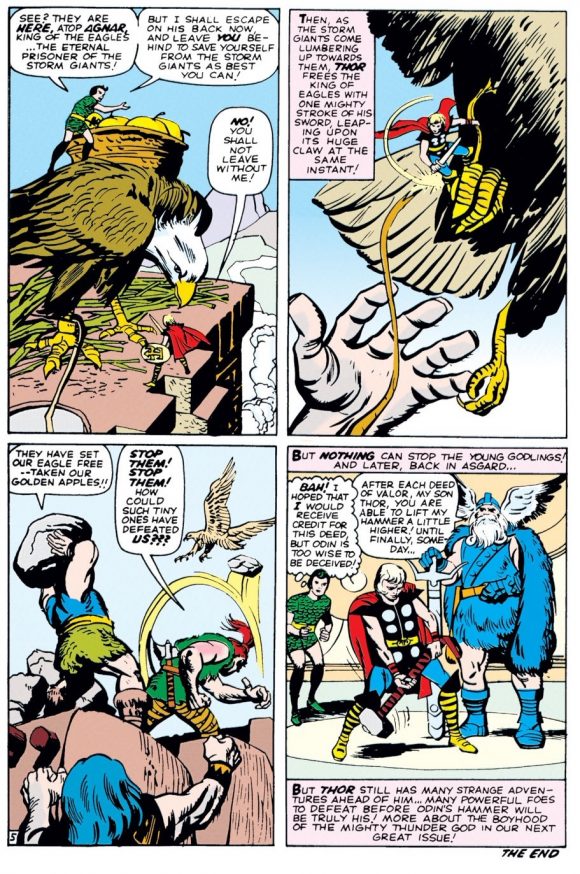
“Tales of Asgard” left Midgard (Earth) and its supervillains behind to focus on Norse mythology and Asgardian world building. The first episode introduced the fierce Norsemen of yore and gave a five-page refresher course on their myths and legends. Going forward, the stories could be about any aspect of the mythology, or Stan and Jack’s comic book version of the Norse gods. One of my favorite early tales was “The Storm Giants,” an Asgardian retelling of the “Jack and the Beanstalk” fable, inked by Paul Reinman.
—
Superman #233, DC (Jan. 1971). Another favorite back-up in the world building business was “The Fabulous World of Krypton,” introduced in Superman #233, the famous “Kryptonite Nevermore” storyline that marked the beginning of Julie Schwartz’s reign as Super-editor.
Even though he made use of more or less the same talent pool as his long-running editorial predecessor Mort Weisinger, Schwartz’s Man of Steel had a very different style and tone. A lot of that no doubt had to do with new Superman writer Denny O’Neil’s hipper and more journalistic style, not to mention the assignment of Murphy Anderson, one of the best artists in the stable, to ink stalwart penciller Curt Swan.
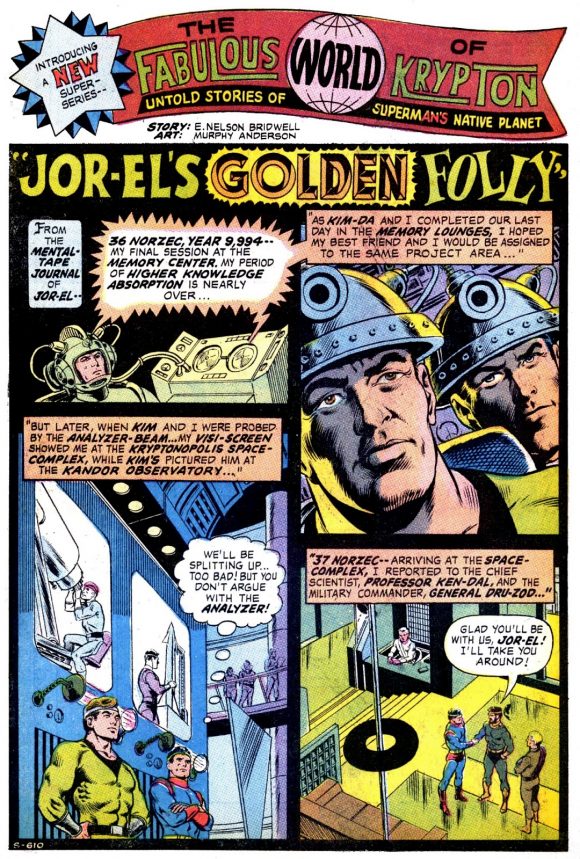
And, while Mort was no slouch in the area of Superman and Kryptonian world building (he introduced everything from Green Kryptonite to Supergirl to the bottle city of Kandor in the comics), “Fabulous World of Krypton” gave these types of stories a place to be told. One of my favorites was the first, “Jor-El’s Golden Folly” by E. Nelson Bridwell and Murphy Anderson. A few years later, my first writing sale to DC would be a “World of Krypton” story for Superman Family, and a few years following that, I would write the World of Krypton miniseries about the life of Jor-El, inked by Murphy Anderson. Synchronicity, Kryptonian style.
—
Our Army at War #151, DC. (Feb. 1965). Robert Kanigher could be a kook, but he was a damn talented one. For every “I Am Rock’s Gun” (Our Army at War #146, Sept. 1964) — a story told from the POV of, I kid you not, Rock’s gun — he would create a Metal Men or Enemy Ace, who made his first appearance in the back of Our Army at War starring Sgt. Rock.

Enemy Ace was Hans von Hammer, a World War I German aviator and master fighter pilot. A man of highest honor, he flew his red Fokker DR-1 triplane in service of his country but took no pleasure in his dozens of enemy kills. The dark, brooding Enemy Ace strip, with art by Joe Kubert, was one of Kanigher’s richest creations.
—
Green Lantern #187, DC. (June 1984). With 3,600 Green Lanterns spread across the universe, the only way to really showcase even a small number of them would be to give them a slot of their own. Hence was born the “Tales of the Green Lantern Corps” back-up feature in Green Lantern, beginning in GL #148 (Jan. 1982) with the story I wrote that introduced GL Ch’p, drawn by Don Newton and Dan Adkins.
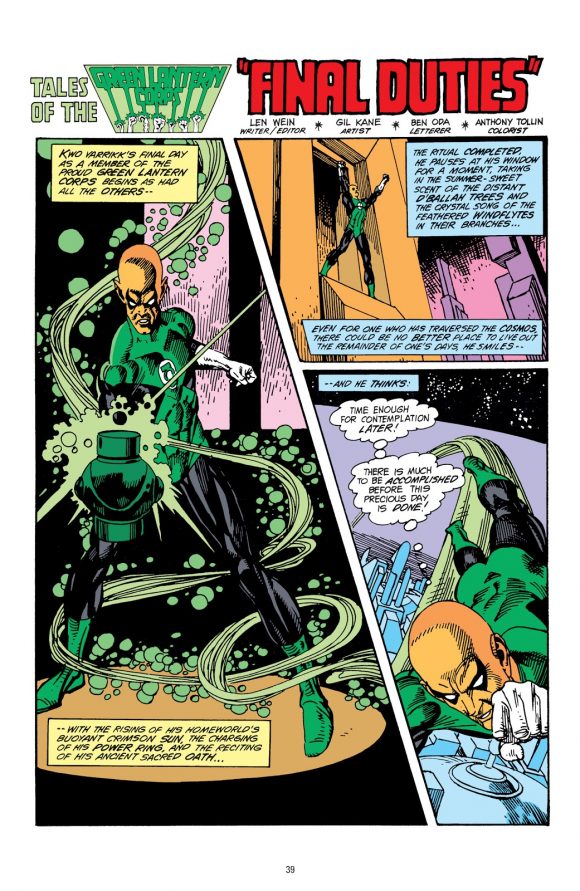
It’s difficult to pick a favorite Tale, but one that stuck with me was Len Wein and Gil Kane’s “Final Duties,” about a retiring Green Lantern’s last day on the job. It’s a simple story offering a glimpse into the mind of a dedicated member of the Corps as he goes through his final shift, reflecting for the last time on the marvels that are the routine of his days.
—
Blue Beetle #4, Charlton. (Dec. 1967). Charlton Comics’ mid-1960s attempt to ride the wave of Batman ’66 TV mania with their line of Action Heroes under the direction of editor Dick Giordano produced any number of memorable reinterpretations of older heroes (Blue Beetle and Captain Atom) and the introduction of several new ones, like Peacemaker, Thunderbolt, Judomaster, and Steve Ditko’s the Question.
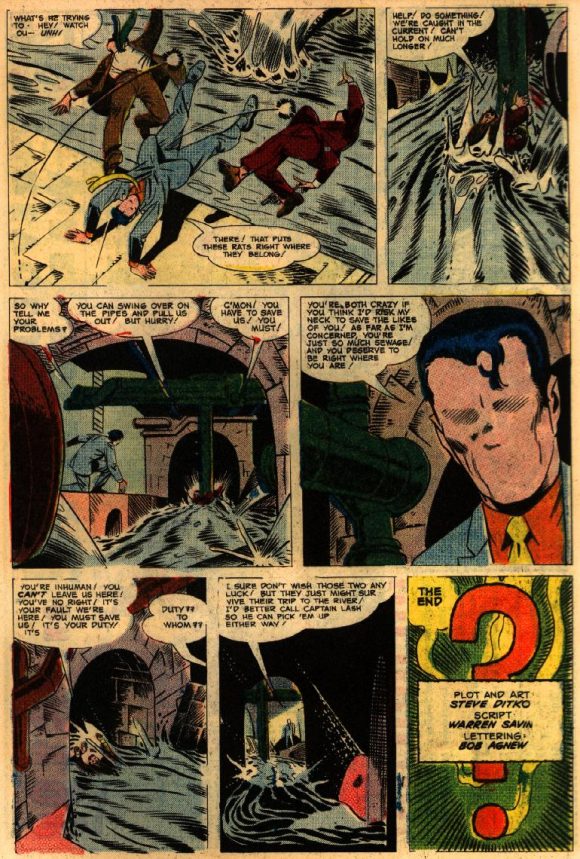
AKA crusading muckraking journalist Vic Sage, the Question was Ditko’s prototype for Mr. A, the embodiment of his Ayn Randian Objectivistic philosophy, and made his debut in the back of Ditko’s Blue Beetle #1 (June 1967). It’s nothing much now, but Question’s ending line about the bad guys he watched get washed away down the sewer — “I sure don’t wish those two any luck! But they just might survive their trip to the river! I’d better call Captain Lash so he can pick ‘em up either way!” — is pretty cold for those Comics Code days.
—
Strange Adventures #147, DC. (Dec. 1962). The Atomic Knights was one of several back-up features that appeared in the Schwartz-edited science fiction anthology, Strange Adventures (others included Captain Comet, Space Museum, Star Hawkins, and the Star Rovers). Written by John Broome and drawn by Murphy Anderson, the Atomic Knights were post-apocalyptic (that darn Hydrogen War of 1986!) soldiers who wore irradiated suits of medieval armor that were impervious to “modern” energy weapons.
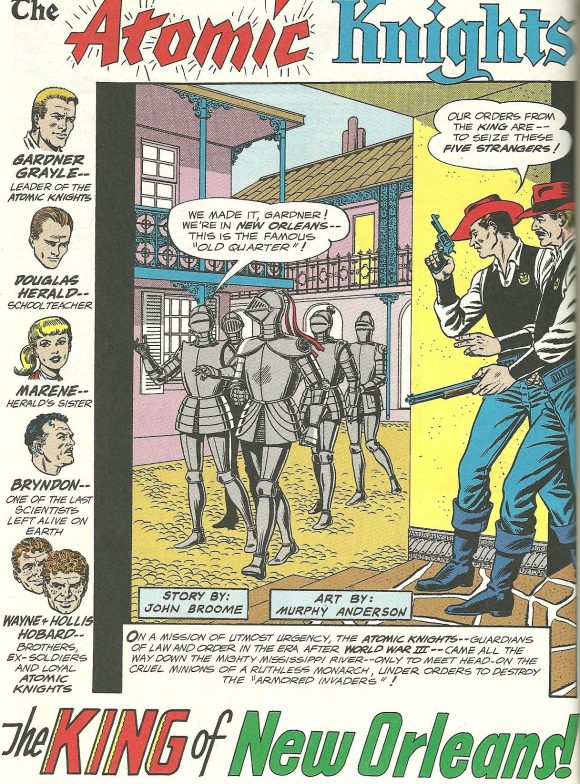
The series was one of Julie’s favorites and was set in “real time”: the stories dealing with the world’s recovery from the shattering war took place at three-month intervals (the feature appeared quarterly, i.e., every three months). It made liberal use of the kind of obscure scientific facts that Schwartz loved, and he got to come up with the plots with his best friend, John Broome. And, because he was such a fan of New Orleans jazz, “The King of New Orleans” was his favorite of the original 15 Atomic Knights tales. I always kind of liked that one too.
—
Batman #219, DC. (Feb. 1970). I think we need a little Christmas, right this very minute, candles in the window and Batman on the spinet!
For a while, Batman Christmas stories were all the rage (because nothing says peace on Earth and goodwill toward man better than a psychotic in a costume beating up on criminals in the night), and some of them have become holiday staples, especially the classic “The Silent Night of the Batman” by Mike Friedrich, Neal Adams and Dick Giordano. It’s Christmas Eve and all across Gotham, inspired by the spirit of Batman, evildoers aren’t doing evil, granting Batman, Commissioner Gordon, and the cops a night of caroling and peace.
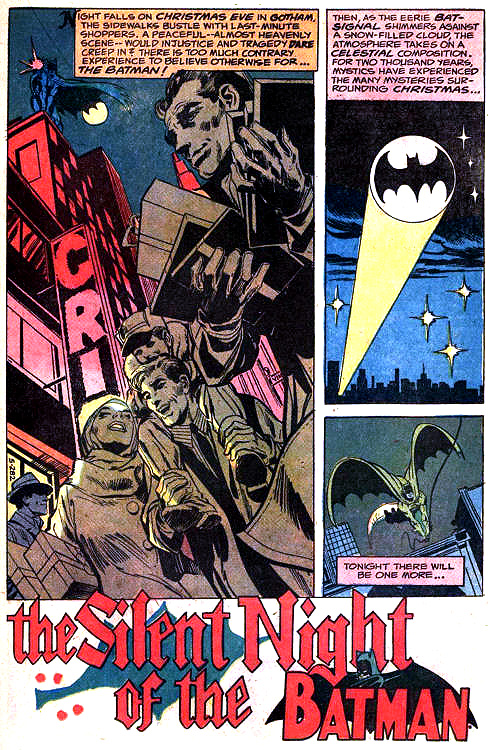
—
DC Special Series #11: Super-Star Holiday Special #21, DC. (1980). Christmas Eve, a missing star from a nativity scene, and an old criminal who takes a job as a department store Santa as part of a big heist, are the elements of the “Batmas” story, “Wanted: Santa Claus — Dead or Alive,” by Denny O’Neil, art by Frank Miller and Steve Mitchell.
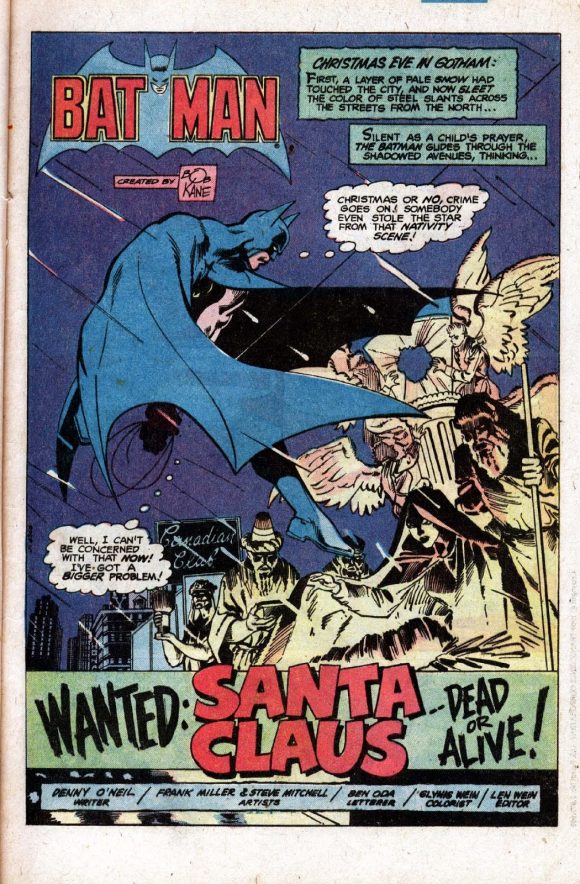
—
Christmas With the Super-Heroes #2, DC. (1988). The final Christmas entry isn’t a real Christmas story, although the holiday does make a cameo appearance and it did appear in a Christmas special. Dave Gibbons and Gray Morrow’s “And In the Depths” is more a history of the Batcave — not only the place itself but what it means to the three people who have spent so much of their lives in those depths: Bruce, Dick, and Alfred. And it was drawn by Gray Morrow, which would make it awesome even it wasn’t. But it is. Merry Christmas!
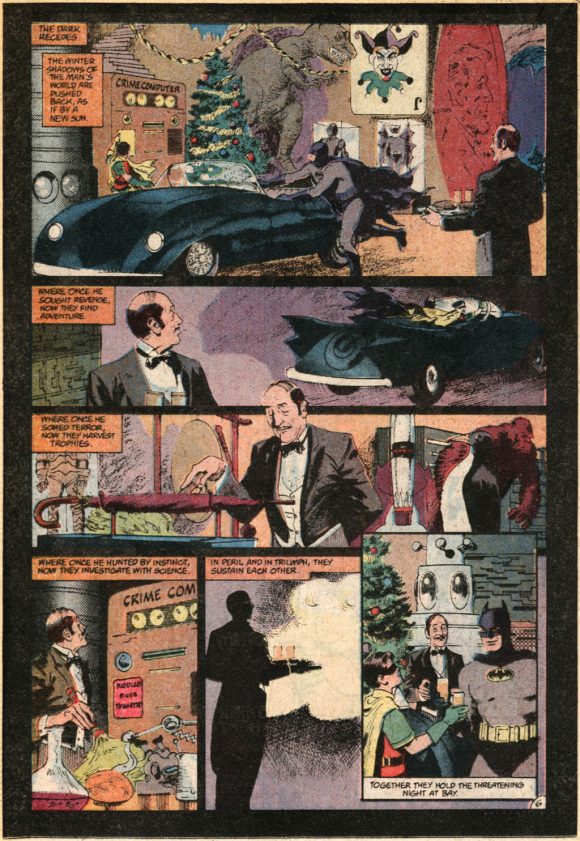
—
The Spirit (Sept. 11, 1949). I first read Will Eisner’s “Ten Minutes” when I picked it up in a batch of Spirit sections at an early 1970s Phil Seuling New York comic convention (they went for $2 or $3 each back then). Like so many Eisner tales (this one co-written by Jules Feiffer), it’s a simple little morality play about ordinary people that takes on operatic proportions in the hands of the master storyteller.
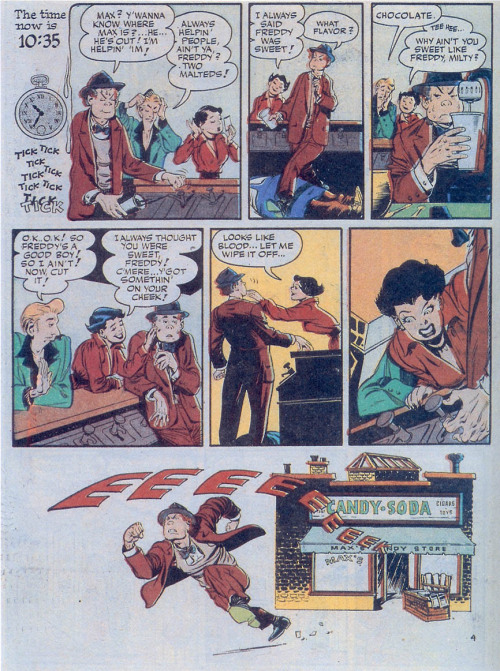
—
Hercules #3, Charlton. (Feb. 1968). Often overlooked in the mid-1960s Charlton Action Hero boom is Hercules, the 13-issue (Oct. 1967-Sept. 1968) “Adventures of the Man-God” from the creative team of Joe Gill and Sam Glanzman. If this were a column about lead features, I’d be all over this fine book.
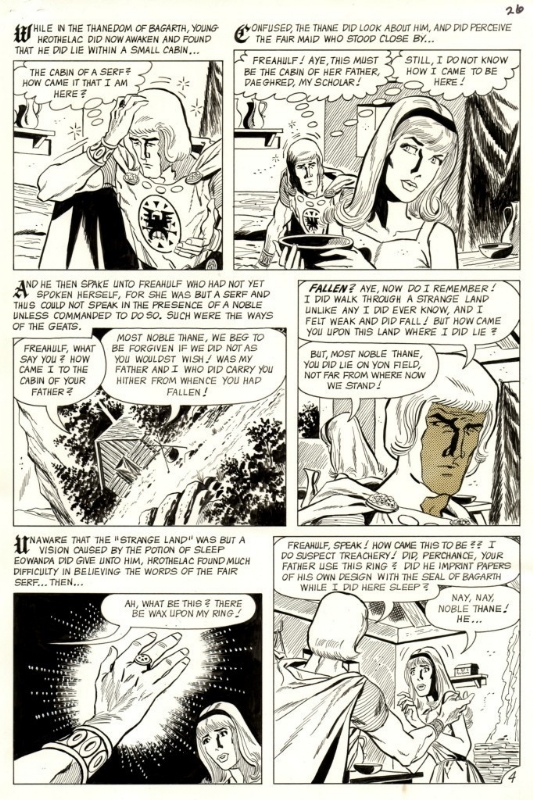
Fortunately, the back-up to the Hercules lead was an ongoing feature called “Thane of Bagarth,” a sword and sorcery strip with an Arthurian slant, set in the period between the two books of the epic Anglo-Saxon tale of Beowulf. A cool concept and even cooler execution by Steve Skeates and legend-in-the-making Jim Aparo (who would be replaced on the last couple of episodes by Sanho Kim). This is a scan of Aparo’s art from Chapter 3, “Banishment.”
—
Korak, Son of Tarzan #46, DC. (May/June 1972). Not much more to say on this one than Edgar Rice Burroughs’ Carson of Venus, Len Wein, and Michael Kaluta. I’m in!
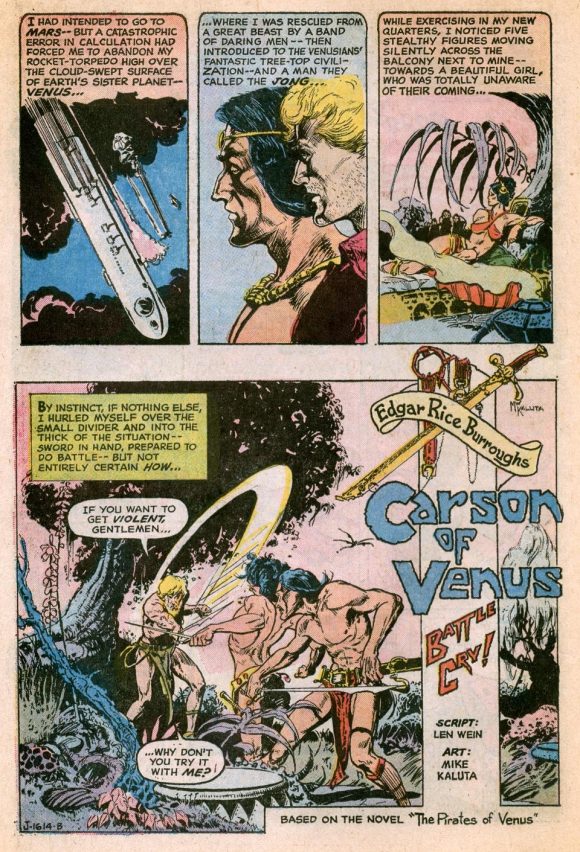
—
MORE
— PAUL KUPPERBERG: My 13 Favorite 1960s SUPERHERO COSTUMES. Click here.
— PAUL KUPPERBERG: My 13 Favorite Short-Lived Series of the 1960s. Click here.
—
Paul Kupperberg has been writing comic books from Archie to Zatanna for 45 years at DC, Archie, Charlton, Marvel, Bongo and others. He is also the author of Paul Kupperberg’s Illustrated Guide to Writing Comics (Charlton Neo Press); I Never Write for the Money… But I Always Turn in the Manuscript for a Check (Comics Career); the comic book industry-based murder mystery The Same Old Story, the short-story collection In My Shorts: Hitler’s Bellhop and Other Stories, and JSA: Ragnarok, all from Crazy 8 Press and all available on Amazon, or signed and personalized direct from Paul (email him at pkupps55@yahoo.com for details).

May 15, 2021
I don’t understand why the current publisher doesn’t offer Michael Kaluta a truckload of money to finish his adaptation of “Lost on Venus.” Or at least collect Kaluta’s Venus stories as so far completed and publish them under one cover. Even incomplete, it’s a work of great skill.
May 15, 2021
I’d say that ship has sailed, sadly. And for me, now a ‘postprint; reader (more digital than otherwise) and also…really, just a reader rather than a collector and living overseas to boot, I find that pretty much everything I’ve ever been interested in reading from those halcyon days are readily available…here and there online. So if you don’t mind reading old silver or bronze digitally on a tablet, it’s a pretty great time to be a fan.
May 16, 2021
Well, the Goodwin/Simonson Manhunter from Detective Comics would be at the top of my list. Probably his initial outing in #437 should get the nod. I also thought many of the Green Arrow stories with art by Dick Giordano or Mike Grell often outshown the lead Superman stories in Action Comics. Kaluta’s Carson of Venus is a good choice, and its sister strip, John Carter of Mars with glorious Murphy Anderson artwork, also merits mention from the back of DC’s Tarzan of the Apes. And if 1-offs are ok (that is, not part of an ongoing series) then I’d nominate Alex Toth’s “Burma Sky” from Archie Goodwin’s Our Fighting Forces series.
May 22, 2021
Well, now, not all of these were back up stories as opposed to stories that were less than book-length.
And if one’s talking back ups, any list that doesn’t mention the Goodwin/Simonson Manhunter* loses a lot of credibility. (*Yes, I know; this is a list of favorites, not best. But the coolest thing about Manhunter is that it showed issue after issue how much story could be jammed into a couple of pages. Of course, they were using like twenty panels to a page, but still.)
November 18, 2023
Keep in mind this isn’t a “Best of” or “Greatest of All Time” list, but a list in which the man shares his personal favorites. While I can certainly see Manhunter on the former lists, my own list of personal favorites wouldn’t include it.
November 18, 2023
I recently reread the two Enemy Ace Archive hardcover books. I don’t think DC has ever had a better series.
November 19, 2023
Love it! Thanks, Paul! I always loved the backup features, especially “World of Krypton” and “Private Life of Clark Kent.” Wonderful storytelling! And I’ll tip my hat to the Metamorpho and Human Target backups (I think) also in Action! I was about sixteen when I bought an old Detective Comics just for the Martian manhunter backup story (about that wonky Idol that kept producing monster-menaces!) $5! My Birthday money! Worth it!